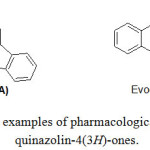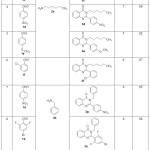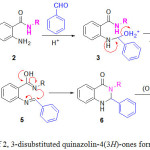Amberlite IR-120 H+ Resin, an Efficient And Recyclable Solid Phase Catalyst for the Synthesis of 2, 3-Disubstituted Quinazolin-4(3H)-Ones: A Greener Approach
Ravi Kumar G. M. V. N. A. R, Thangamani Arumugam, Venkata Reddy Gayam and Ravi Subban
Department of Chemistry, Karpagam University, Karpagam academy of higher education, Coimbatore-641021, Tamil Nadu, India.
Corresponding Author E-mail: Thangabell2003@gmail.com
DOI : http://dx.doi.org/10.13005/ojc/330453
A highly efficient synthesis of 2,3-disubstituted quinazolin-4(3H)-ones via Amberlite IR 120 H+ resin. Amberlite IR 120 H+ is a commercially available, heterogeneous and recoverable catalyst to synthesize the 2,3-disubstituted quinazolin-4(3H)-ones in excellent yields.
KEYWORDS:MCR strategy; Amberlite IR 120 H+ resin; Quinazolin-4(3H)-ones; Greener approach; Reusability
Download this article as:| Copy the following to cite this article: Kumar R. G. M. V. N. A. R, Arumugam T, Gayam V. R, Subban R. Amberlite IR-120 H+ Resin, an Efficient And Recyclable Solid Phase Catalyst for the Synthesis of 2, 3-Disubstituted Quinazolin-4(3H)-Ones: A Greener Approach. Orient J Chem 2017;33(4). |
| Copy the following to cite this URL: Kumar R. G. M. V. N. A. R, Arumugam T, Gayam V. R, Subban R. Amberlite IR-120 H+ Resin, an Efficient And Recyclable Solid Phase Catalyst for the Synthesis of 2, 3-Disubstituted Quinazolin-4(3H)-Ones: A Greener Approach. Orient J Chem 2017;33(4). Available from: http://www.orientjchem.org/?p=34932 |
Introduction
Quinazolines, quinazolinones frequently encountered chemical structure in several naturally occurring alkaloids and are of significant importance in medicinal chemistrydue to their wide range of pharmacological activities these molecules acquired an important role in the medicinal chemistry. In general, these quinazolin-4(3H)-ones alkaloids have gained profound interest owing to their promising biological activity 1-4 viz., anti-cancer,5 anti-convulsant,6 anti-bacterial,7 antiulcer,8 anti-fungal,9 analgesic,10 anti-inflammatory 11 and anti-hypertensive.12Rutaecarpine (Fig. 1, entry-A), a natural occurring alkaloid containing indolopyridoquinazolinone core structure was first isolated from Evodia Rutaecarpa by Asahina and co-workers in 1915.
 |
Figure 1: Few examples of pharmacologically important quinazolin-4(3H)-ones. |
Evodiamine (Fig. 1, entry-B), is a quinazolin-carboline alkaloid isolated from the fruit of Evodia rutaecarpa which is widely utilized in Chinese medicine as an antidote for several health disorders such as resisting tumour, antinociception, weight loss, protecting heart and reducing blood pressure.
Previously, these type of compounds were synthesized by using silica-sulfuric acid13, p-TSA14, Magnetic Fe3O4 Nanoparticles15, Montomorillonite K1016.Amberlite IR 120 His Industrial Grade Strong Acid Cation Exchange Resin. It was previously used for various chemical transformations17-19. It is a nonhazardous and cheap catalyst. In the present invention we prepared various 2, 3-disubstituted quinazolin-4(3H)-ones by using Amberlite IR-120 H+ Resin in good yields. So the Amberlite IR 120 H+ was found to be the best recoverable heterogeneous catalyst for the synthesis of Quinazoline-4(3H)-one derivatives.
Results and Discussion
Total 11 number of quinazoline-4(3H)-one derivatives were synthesized by treating isatoic anhydride with different aldehydes and amines as mentioned in the table-1. The obtained products were confirmed by NMR, IR and Mass.
 |
Table 1: Synthesis of 2.3-disubstituted quinazolin-4(3H)-ones |
Plausible Mechanism
A step wise possible mechanism for the formation of 2, 3-disubstituted quinazolin-4(3H)-ones 7 is illustrated in Fig. 2. The primary amine attack on carbonyl group of isatoic anhydride 1, followed by ring opening and decarboxylation provided the amide compound2. The Nucleophile attack of amine to a carbonyl group of aldehyde and further dehydration under acidic medium provided the compound 4. Compound 5 cyclization and oxidation under air balloon to provided them as a solid compound 7.
 |
Figure 2: of 2, 3-disubstituted quinazolin-4(3H)-ones formation |
Experimental Section
All the reagents used in the present work were of Analytical Reagent/ Laboratory Reagent grade. The 1H and 13C NMR spectra were determined in CDCl3/DMSO-d6 solution using Varian Gemini 2000 model 200MHz instrument and Oxford magnet Varian Mercury 400MHz instrument. The 1H chemical shift values were reported on the d scale in ppm, relative to TMS (d= 0.00 ppm), while 13C chemical shifts relative to CDCl3 and DMSO-d6 (d = 39.5 ppm) as internal standards. Spin multiplicities are given as s (singlet), d (doublet), t (triplet) and m (multiplet) as well as br (broad). Coupling constants (J) are given in hertz (Hz).
Mass spectra were run on an Agilent 1100 series LC system coupled to a triple quadrupole mass spectrometer (Agilent LC/MS/MS model 6410, Agilent Technologies Inc., Santa Clara, CA, USA) with electrospray ionization (ESI) source. The high-resolution mass spectra (HRMS) were determined using Waters LCT Premier time-of-flight mass spectrometer (Milford, USA) with ESI source.
Infrared spectra (IR) for all samples were recorded on Perkin Elmer 1650 FT IR spectrometer. All reactions were monitored by thin layer chromatography (TLC) on silica gel plates (60 F254), visualizing with ultraviolet light or iodine spray. Column chromatography was performed on silica gel (230-400 mesh) using distilled petroleum ether and ethyl acetate.
General Procedure for the Synthesis of Disubstituted Quinazolin-4(3H)-Ones
In a 25 mL round bottom flask, isatoic anhydride (1.0 mmol), aldehyde (1.0 mmol), amine (1.1 mmol), Amberlite IR-120 H+ resin (300 mg) and water + Acetonitrile (20 mL) were heated to reflux under air balloon for 5 to 8 h. The progress of the reaction was monitored by TLC. After completion of the reaction, the mixture was cooled to room temperature, water (20 mL) and ethyl acetate (20 mL) were added and stirred for about 10 min, filtered and washed with ethyl acetate (20 mL) and both layers separated. The organic layer was washed with water (20 mL) and 10 %NaCl solution. The organic layer was dried with anhyd Na2SO4, and concentrated under reduced pressure. The crude mass was recrystallized using methanol to afford the products in good yields (3a to 3k). The catalyst was recovered by washing with fresh water (2-3 times) and dried in vacuum oven at 50°C then it was reused for another cycle.
All the Compounds Gave Satisfactory Analytical and Spectral Data
3-Hexyl-2-Phenylquinazolin-4(3H)-one (3a)
Brown solid; Yield- 92 %; IR (KBr) = 3345, 2928, 1642, 1525, 1449, 1302, 1159, 758 cm-1; 1H NMR (400 MHz, CDCl3): δ= 8.34 (d, J = 7.6 Hz, 1H), 8.11 (d, J= 5.2 Hz, 1H), 7.78-7.72 (m, 2H), 7.54-7.49 (m, 5H), 3.99-3.95 (m, 2H), 1.66-1.58 (m, 2H), 1.40-1.34 (m, 6H), 0.93-0.89 (m, 3H); 13CNMR (100 MHz, CDCl3): δ = 162.1, 156.2, 147.1, 135.5, 134.2, 133.6, 130.1, 129.7, 128.7, 128.4, 127.7, 127.3, 126.9, 126.7, 45.9, 30.9, 28.5, 26.2, 22.3, 13.8; HRMS: m/z calcd for C20H23N2O (M+H) 308.1817, found : 308.1805
2-(4-Bromo-2, 6-Difluorophenyl)-3-Hexylquinazolin-4 (3H)-one (3b)
Brown solid; Yield- 88%; IR (KBr) = 3325, 1672, 1548, 1310, 1076, 984, 858, 797, 745, 692, 450, cm-1; 1H NMR (400 MHz, CDCl3): δ= 8.36 (d, J = 8.0 Hz, 1H), 7.80-7.70 (m, 2H), 7.57-7.53 (m, 1H), 7.30-7.26 (m, 2H), 3.90-3.86 (m, 2H), 1.60-1.54 (m, 2H), 1.25-1.13 (m, 6H), 0.89-0.81 (m, 3H); 13CNMR (100 MHz, CDCl3): δ = 174.8, 161.61, 161.0, 158.4, 134.4, 127.7, 127.5, 126.9, 124.4, 121.3, 116.3, 116.0, 45.8. 31.0, 28.2, 26.2, 22.2, 13.8; HRMS: m/z calcd for C20H20N2OF2Br (M+H) 421.0721, found: 421.0749.
2-(4-Fluorophenyl)-3-Hexyl Quinazolin-4 (3H)-one (3c)
Brown solid; Yield- 84%; IR (KBr) 3327, 2856, 1681, 1525, 1491, 1073, 887, 761, 585, 527, cm-1; 1H NMR (400 MHz, CDCl3): δ= 8.33 (d, J = 7.6 Hz, 1H), 7.78-7.70 (m, 2H), 7.55-7.51 (m, 3H), 7.26-7.19 (m, 2H), 3.99-3.96 (m, 2H), 1.66-1.52 (m, 2H), 1.43-1.36 (m, 6H), 0.91-0.88 (m, 3H); 13CNMR (100 MHz, CDCl3): δ = 175.1, 134.3, 130.0, 129.9, 127.4, 127.1, 126.7, 116.0, 115.8, 45.9, 31.0, 28.5, 26.2, 22.3, 13.8; HRMS: m/z calcd for C20H20N2OF (M+H) 325.1716, found: 325.1717.
3-Hexyl-2-(4-Nitrophenyl) Quinazolin-4(3H)-one (3d)
Yellow solid; Yield- 89%; IR (KBr)= 3322, 1676, 1547, 1310, 1076, 984, 857, 797, 745, 692, 452, cm–1 ; 1H NMR (400 MHz, CDCl3): δ = 8.42-8.40 (m, 2H), 7.82-7.76 (m, 4H), 7.58-7.43 (m, 2H), 3.98-3.95 (m, 2H), 1.67-1.52 (m, 2H), 1.42-1.35 9m, 6H), 0.92-0.88 (m, 3H); 13CNMR (100 MHz, CDCl3): δ = 161.7, 153.8, 148.4, 146.8, 141.4, 134.5, 131.2, 129.2, 128.5, 127.6, 127.5, 126.9, 126.7, 124.0, 45.9, 31.0, 28.7, 26.2, 22.3, 13.8; HRMS: m/z calcd for C20H22N3O3 (M+H) 352.1661, found: 352.1674.
3-Hexyl-2-(4-Methoxyphenyl) Quinazolin-4(3H)-one (3e)
White solid; Yield- 82%; IR (KBr) 3337, 2923, 1682, 1512, 1446, 1278, 1006, 901, 662, 546, cm-1; 1H NMR (400 MHz, CDCl3): δ= 8.32 (d, J = 7.2 Hz, 1H), 7.74-7.70 (m, 1H), 7.50-7.46 (m, 2H), 7.31-7.26 (m, 2H), 7.04-7.00 (m, 1H), 6.87-6.83 (m, 1H), 4.02-3.98 (m, 2H), 3.88 (s, 3H), 1.62-1.56 (m, 2H), 1.25-1.88 (m, 6H), 0.86-0.79 (m, 3H); 13CNMR (100 MHz, CDCl3): δ = 162.3, 160.6, 156.1, 147.2, 134.1, 133.2, 128.0, 127.3, 126.7, 126.7, 120.8, 119.1, 114.1, 114.1, 55.4, 45.9, 31.0, 27.5, 26.3, 22.3, 13.8; HRMS: m/z calcd for C21H25N2O2 (M+H) 337.1916, found: 337.1916.
2-(2-Chlorophenyl)-3-Hexylquinazolin-4(3H)-one (3f)
White solid; Yield- 87%; IR (KBr) 3345, 2928, 1642, 1525, 1449, 1302, 1159, 758 cm-1; 1H NMR (400 MHz, CDCl3): δ= 8.36 (d, J = 8.4 Hz, 1H), 7.79-7.75 (m, 2H), 7.55-7.42 (m, 5H), 4.26-4.19 (m, 1H), 3.53-3.45 (m, 3H), 1.72-1.61 (m, 1H), 1.55-1.25 (m, 1H), 1.21-1.10 (m, 6H), 0.89-0.81 (m, 3H); 13CNMR (100 MHz, CDCl3): δ = 175.2, 161.8, 153.4, 147.2, 134.5, 134.2, 132.4, 131.0, 129.8, 129.8, 127.5, 127.2, 127.2, 126.8, 45.5, 30.9, 28.3, 26.3, 22.2, 13.8; HRMS: m/z calcd for C20H22N2O2Cl (M+H) 341.1421, found: 341.1406.
3-Benzyl-2-(4-Nitrophenyl) Quinazolin-4(3H)-one (3g)
Yellow solid; Yield- 85 %; IR (KBr)= 3323, 1676, 1543, 1310, 1076, 985, 857, 798, 744, 692, 451, cm–1 ; 1H NMR (400 MHz, CDCl3): δ = 8.39-8.37 (m, 1H), 7.79-7.73 (m, 2H), 7.56-7.52 (m, 1H), 7.33-7.30 (m, 2H), 7.26-7.21 (m, 3H), 7.10-7.09 (m, 2H), 6.93-6.91 (m, 2H), 5.26 (s, 2H); 13CNMR (100 MHz, CDCl3): δ = 162.0, 154.1, 148.4, 145.9, 140.9, 135.9 (2C), 134.8 (2C), 129.3, 128.8, 128.0, 127.8, 127.8, 127.6, 127.2, 126.6, 124.1, 123.6, 120.8, 48.6; HRMS: m/z calcd for C21H16N3O3 (M+H) 358.1292, found: 358.1206.
3-Benzyl-2-(4-Bromo-2, 6-Difluorophenyl) Quinazolin-4 (3H)-one (3h)
Brown solid; Yield- 86%; IR (KBr) = 3325, 1672, 1548, 1310, 1076, 984, 858, 797, 745, 692, 450, cm-1;
1H NMR (400 MHz, CDCl3): δ = 8.42-8.39 (m, 1H), 7.83-7.81 (m, 1H), 7.79-7.74 (m, 1H), 7.60-7.58 (m, 1H), 7.25-7.18 (m, 5H), 6.90-6.89 (m, 2H), 5.29-5.21 (m, 2H); 13CNMR (100 MHz, CDCl3): δ = 162.0, 160.9, 160.8, 158.4, 158.3, 147.0, 145.5, 135.5, 134.6, 128.5, 128.0, 127.8, 127.7, 127.2, 126.9, 124.4, 121.2, 116.0, 115.8, 115.7, 48.0; HRMS: m/z calcd for C21H14N2OF2Br (M+H) 427.0258, found: 427.0264.
3-(4-Methoxybenzyl)-2-(4-Methoxy Phenyl) Quinazolin-4(3H)-one (3i)
White solid; Yield- 82 %; IR (KBr) 3327, 2928, 1638, 1512, 1428, 809, 580, cm-1; 1H NMR (400 MHz, CDCl3): δ = 8.05-8.01 (m, 1H), 7.76-7.74 (m, 1H), 7.33 (d, J= 5.2 Hz, 1H), 7.26-7.19 (m, 2H), 6.95-6.75 (m, 7H), 3.87 (s, 2H), 3.78 (s, 6H); 13CNMR (100 MHz, CDCl3): δ = 163.2, 162.6, 160.7, 160.2, 147.2, 134.3, 133.5, 132.1, 131.4, 129.7, 127.8, 127.4, 127.0, 126.9, 120.7, 119.0, 115.7, 114.1, 114.1, 113.9, 55.4, 55.2, 46.0; HRMS: m/z calcd for C23H21N2O3 (M+H) 373.1552, found: 373.1548.
3-(4-Methoxybenzyl)-2-(4-Nitrophenyl) Quinazolin-4(3H)-one (3j)
Yellow solid; Yield- 89 %; IR (KBr)= 3332, 1686, 1567, 1330, 1066, 984, 857, 797, 745, 692, 462, cm–1 ; 1H NMR (400 MHz, CDCl3): δ = 8.42-8.39 (m, 1H), 8.28 (d, J= 8.8 Hz, 2H), 7.84-7.80 (m, 1H), 7.75 (d, J= 8.0 Hz, 1H), 7.61-7.50 (m, 3H), 6.81-6.73 (m, 4H), 5.18 (s, 2H), 3.76 (s, 3H); 13CNMR (100 MHz, CDCl3): δ = 163.2, 162.6, 160.7, 147.2, 133.5, 132.1, 131.4, 129.7, 129.4, 128.8, 128.7, 128.0, 127.8, 127.4, 126.9, 120.7, 119.0, 115.7, 114.1, 114.1, 55.2, 46.0; HRMS: m/z calcd for C22H18N3O4 (M+H) 388.1297, found: 388.1208.
3-(4-Methoxy Benzyl)-2-(4-Bromo-2, 6-Difluorophenyl) Quinazolin-4(3H)-one (3k)
White solid; Yield- 82 %; IR (KBr) 3322, 2929, 1648, 1532, 1428, 801, 582, cm-1; 1H NMR (400 MHz, CDCl3): δ = 8.41-8.38 (m, 1H), 7.82-7.78 (m, 1H), 7.73-7.71 (m, 1H), 7.60-7.56 (m, 1H), 7.17 (d, J= 6.4 Hz, 2H), 6.84 (d, J = 8.8 Hz, 2H), 6.73-6.69 (m, 2H), 5.14 (s, 2H), 3.75 (s, 3H); 13CNMR (100 MHz, CDCl3): δ = 162.0, 160.9, 160.8, 159.1, 158.3, 146.9, 145.5, 134.6, 128.5, 127.9, 127.6, 127.6, 127.2, 124.4, 121.3, 116.0, 116.0, 115.9, 115.8, 113.7, 55.2, 47.5; HRMS: m/z calcd for C22H16N2O2F2Br (M+H) 457.0363, found: 457.0367.
Conclusion
In conclusion, we have developed an efficient and environmentally benign synthetic method for the synthesis of 2, 3- disubstituted quinazolin-4(3H)-ones from isatoic anhydride, aldehyde and amines using Amberlite IR-120 H+ resin, a commercially available green and recyclable catalyst. The advantages of this method are simplicity of operation, clean reactions, and absence of side products, recyclable and high yields.
References
- Mhaske, S. B.; Argade, N. P. Tetrahedron 2006, 16, 9787.
CrossRef - Kurogi, Y.; Inoue, Y.; Tsutsumi, K.; Nakamura, S.; Nagao, K.; Yohsitsugu, H.; Tsuda, Y.; J. Med. Chem.1996, 39, 1443.
CrossRef - Kung, P. P.; Casper, M. D.; Risen, L. M.; Vickers, T. A.; Ranken, R.; Ecker, D. J.; J. Med. Chem.1999,42, 4705.
CrossRef - Gueyrard, D.; Gurnel, V.; Leoni, O.; Palmieri, S.; Rollin, P.Heterocycles 2000,52,827.
CrossRef - Murugan, V.; Kulkarni, M.; Anand, R. M.; Kumar, E. P.; Suresh, B.; Reddy, V. M.; Asian J. Chem. 2006,18, 900.
- Wolfe, J. F.; Rathman, T. L.; Sleevi, M. C.; Campbell, J. A.; Greenwood, T. D.; J. Med. Chem. 1990,33, 161.
CrossRef - Selvam, P.; Girija, K.; Nagarajan, G.; De Clerco, E. Indian.; J. Pharm. Sci. 2005,67, 484.
- Tereshima, K.; Shimamura, H.; Kawase, A.; Tanaka, Y.; Tanimura, T.; Kamisaki, T.; Ishizuka, Y.; Sato,; M. Chem. Pharm. Bull. 1995,43,2021.
- Liverton, N. J.; Armstong, D. J.; Claremon, D. A.; Remy, D. C.; Baldwin, J. J.; Lynch, R. J.; Zhang, G.; Gould, R. Bioorg.; Med. Chem. Lett. 1998,8,483.
CrossRef - Jiang, J. B.; Hesson, D. P.; Dusak, B. A.; Dexter, D. L.; Kang, G. J.; Hamel, E. J.; Med. Chem. 1990,33, 1721.
CrossRef - Alagarsamy, V.; Raja, S. V.; Dhanabal, K.; Bioorg. Med. Chem. 2007,15,235.
CrossRef - Alagarsamy, V.; Pathak, Urvishbhai, S.; Bioorg. Med. Chem. 2007,15, 3457.
CrossRef - Salehi, P.; Dabiri, M.; Zolfigol, M. A.; Baghbanzdeh, M. A . Synlett 2005,1155–1157.
CrossRef - Baghbanzdeh, M.; Salehi, P.; Dabiri, M.; Kozehgary, G; Synthesis 2006,344–348.
- Zhan-Hui Zhang, Hong-Yan Lu¨, Shu-Hong Yang, and Jian-Wu Gao; J. Comb. Chem. 2010, 12, 643–646
CrossRef - Salehi, P.; Dabiri, M.; Baghbanzadeh, M.; Bahramnejad, M; Synth. Commun. 2006, 2287–2292.
CrossRef - Tewari, N.; Katiyar, D.; Tiwari, V. K.; Tripathi, R. P. Tetrahedron Lett.2003, 44, 6639.
CrossRef - Akagawa, K.; Sakamoto, S.; Kudo, K.;Tetrahedron Lett. 2007, 48, 985.
CrossRef - Park, T.-J.; Weiwer, M.; Yuan, X.; Baytas, S. N.; Munoz, E. M.; Murugesan, S.; Linhardt, R. J.; Carbohydr. Res.2007, 342, 614.
CrossRef

This work is licensed under a Creative Commons Attribution 4.0 International License.









